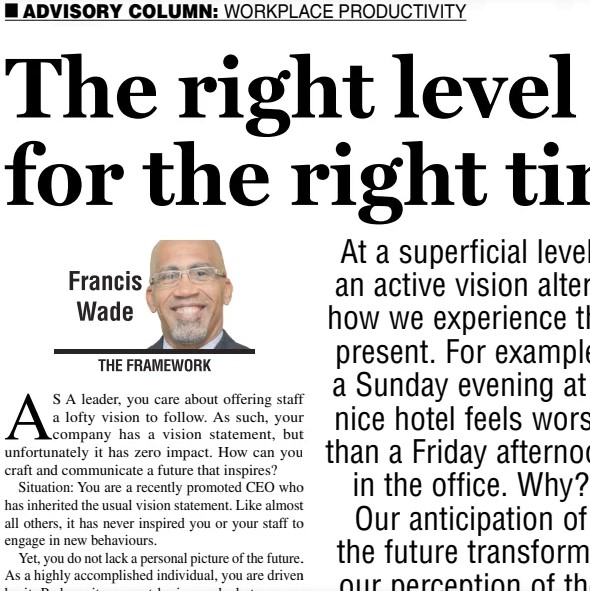As a leader, you recognize the importance of inspiring your team with a compelling vision. Yet, you may find that your company’s vision statement, despite its lofty aspirations, fails to inspire meaningful change. How can you craft and communicate a future that genuinely motivates your team to take action?
The Challenge of an Inherited Vision Statement
Imagine you’re a newly promoted CEO. Among the many responsibilities you’ve inherited is a vision statement. While it might look passable on paper, it has yet to inspire you, let alone your team, to embrace new behaviors or think differently.
It’s not that you lack vision yourself—after all, your success is built on envisioning possibilities and pursuing them. But translating that personal energy into an organizational vision that resonates with others is a different challenge altogether. Should you simply rewrite the vision statement, or is there a better way to achieve meaningful impact?
Here’s a fresh approach to this age-old leadership dilemma.
Understanding How Vision Truly Works
A powerful vision fundamentally transforms how we experience the present. Think about the difference between a Friday afternoon in the office and a Sunday afternoon. The former often feels better—not because of the immediate circumstances but because of our anticipation of the weekend. This sense of future anticipation changes how we perceive the present moment.
That’s the kind of shift you want to inspire in your stakeholders. You want them to feel energized by the future you’re describing, just as you are. The hallmark of success is when individuals take initiative, make sacrifices, and go beyond their job descriptions—not because they’re told to, but because they’re inspired to.
But here’s the hard truth: a traditional vision statement alone cannot deliver this kind of transformative impact.
Rethinking Vision: Introducing the Three Levels
Most organizations begin with what can be termed a “Level 1 Vision”: a concise, polished statement, often a few sentences or paragraphs, that attempts to summarize the future. However, these statements are frequently vague, generic, and uninspiring. They might sound nice but leave people either indifferent or skeptical. Some may even feel the statement describes what the organization has already achieved, rendering it irrelevant.
A better approach is to think of the Level 1 Vision as just the “headline” of a more detailed vision framework. Here’s how to expand it.
Building a Level 2 Vision
To create a meaningful vision at this level, gather your leadership team for an offsite retreat and focus on a specific long-term horizon—typically 15 to 30 years in the future. Work together to describe a vivid picture of what success looks like at that time. This Level 2 Vision goes beyond a brief statement; it provides several pages of detail, potentially including visuals, videos, or other media to bring the future to life.
The key here is collaboration. By involving your leadership team, you not only create a shared sense of ownership but also tap into a wider pool of creativity and ambition. A well-crafted Level 2 Vision should reflect the aspirations of your entire C-suite, energizing everyone involved.
However, many organizations stop at this stage. While the Level 2 Vision is more compelling than a simple statement, it often becomes an overwhelming list of aspirations. Without prioritization (and reduction), it risks becoming unrealistic, leading to cynicism rather than inspiration. Some employees may even dismiss it as “the CEO’s wish list.”
To avoid this pitfall, you must take the next step.
Evolving to a Level 3 Vision
The “Level 3 Vision” transforms lofty aspirations into a credible, actionable plan. This involves narrowing down the vision to a focused set of achievable targets supported by a strategic roadmap.
This process requires tough conversations. Your leadership team will need to negotiate priorities, confront trade-offs, and align on a clear path forward. Engaging a skilled facilitator can help ensure these discussions are productive and lead to consensus.
The outcome is a vision that stands apart from your competitors. A Level 3 Vision includes:
– Specific, measurable results: Clearly defined goals with tangible metrics.
– Milestones: Key achievements along the journey to the ultimate vision.
– A strategic pathway: A roadmap showing how to get from the present to the desired future.
– Team alignment: Full buy-in from your leadership team, ensuring commitment to execution.
With this, your vision evolves from an abstract dream into a realistic plan that inspires action.
Communicating Across the Three Levels
Once your Level 3 Vision is established, it’s crucial to communicate it effectively. Each level of vision—Level 1, Level 2, and Level 3—has a role to play depending on your audience and context.
For example, a Level 1 Vision offers a concise, memorable summary. Think of Vision 2030 Jamaica’s tagline: “…the place of choice to live, work, raise families and do business.” It’s short, evocative, and easy to recall.
A Level 2 Vision, on the other hand, provides more depth. Vision 2030 Jamaica expands on its tagline with four National Goals and 15 Outcomes, offering stakeholders a richer understanding of the country’s aspirations.
Finally, a Level 3 Vision delivers the detailed roadmap necessary to ensure credibility and guide execution.
By mastering these three levels, you can tailor your communication to inspire stakeholders while maintaining clarity and focus. Avoid the mistake of using the wrong level for the audience or situation, which can lead to confusion or disengagement.
Conclusion
Transforming vision statements into actionable, inspiring frameworks requires more than polished language. By embracing a three-level approach, you can align your team, inspire stakeholders, and chart a credible path to the future. Choose the right level of vision for the right moment, and you’ll not only communicate your aspirations—you’ll make them a reality.

